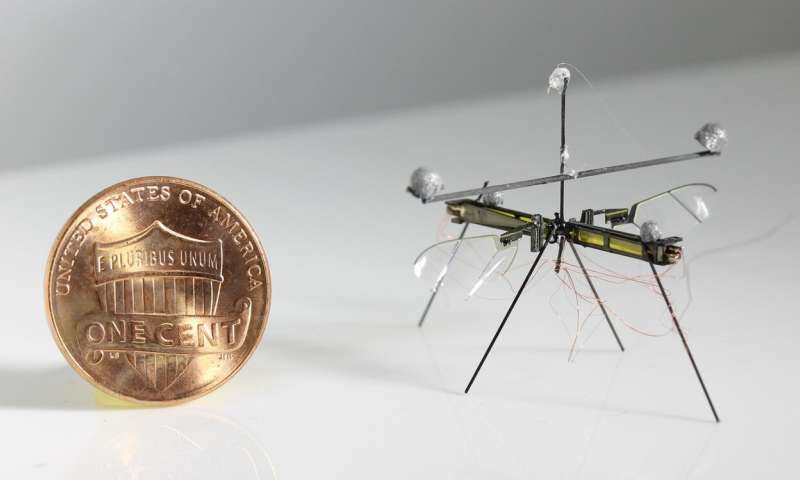
Insect-size robots could have numerous useful applications, for instance, aiding search and rescue (SAR) missions, simplifying the inspection of infrastructures and speeding up agricultural processes. Despite the advantages associated with their size, these robots can be very difficult to build, as their fabrication involves assembling several tiny components.
To overcome these limitations, researchers at the University of Washington have recently created RoboFly, a 74-mg flapping-wing robot that can move in the air, on the ground and on water surfaces. The new robot, presented in a paper pre-published on arXiv, was built using fewer components than those generally used to build insect-size robots, which greatly simplifies its fabrication.
"RoboFly is a flapping-wing micro-robot inspired by flying insects," Yogesh Chukewad, one of the researchers who carried out the study, told TechXplore. "These insects can fly, walk, and some of them can also skim on the water surface. The goal of our research was to develop a robot that mimics its biological counterpart by performing multi-modal locomotion, which includes aerial, ground, and water surface locomotion."
The tiny robot created by Chukewad and his colleagues is an adaptation of RoboBee, a flying micro-robot prototype that Sawyer Fuller, senior author and principal investigator on the study, helped to develop at Harvard University before he started working at the University of Washington. A key improvement of RoboFly is that it has fewer components, as the researchers found that assembling too many parts made its fabrication overly complex.
"The way RoboBee was designed made it really difficult to build," Chukewad explained. "Currently, most insect-size robots are built under a microscope, assembled carefully by hand, as they have many separate microscopic parts. If you accidentally drop a part the size of a sesame seed in a busy lab, you're never going to see it again!"
To simplify RoboFly's fabrication, the researchers created a new design, in which the robot's chassis is comprised of a single, folded laminate sheet. One can thus build the robot without having to assemble many microscopic parts. The chassis is also lower and thus closer to the ground, which enables three different types of locomotion.
"RoboFly makes use of its two flapping wings driven by piezoelectric actuators to fly and hover, like some insects do," Chukewad said. "It can also move and steer on the ground by making use of the same set of flapping wings. Because of its light-weight property, if modified with a set of three foot-like appendages it can land on water surfaces. Once it landed, the robot can then move and steer on water using the same principle that is used to move on the ground."
The fact that it can fly, walk and drift on water makes RoboFly unique, setting it apart from other insect-size robots. The robot could be far more effective than existing ones in avoiding obstacles, as it can simply switch to a different mode of locomotion (e.g. flying or moving on water if it detects obstacles on the ground).
Should it be commercialized, RoboFly could have several potential uses, for instance, helping human users to detect gas leaks or assisting volunteers on search and rescue missions. It could also be deployed in large numbers on water surfaces to search for pollutants or leaks of potentially hazardous fluids (e.g. fuel from an airplane disaster).
"Now that we ascertained that RoboFly can perform multi-modal locomotion, our next objective will be to use it as a tool to better understand the behavior of its biological counterparts," Chukewad said.
More information: RoboFly: an insect-sized robot with simplified fabrication that is capable of flight, ground, and water surface locomotion. arXiv:2001.02320 [cs.RO]. arxiv.org/abs/2001.02320
Provided by Science X Network
© 2020 Science X Network
Citation: RoboFly: An insect-sized robot that can fly, walk and drift on water surfaces (2020, January 29) retrieved 29 January 2020 from https://techxplore.com/news/2020-01-robofly-insect-sized-robot-drift-surfaces.html
This document is subject to copyright. Apart from any fair dealing for the purpose of private study or research, no part may be reproduced without the written permission. The content is provided for information purposes only.
